
The Leotiomycetes are a class of ascomycete fungi. Many of them cause serious plant diseases.
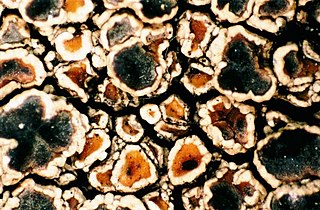
Megasporaceae are a family of fungi belonging to the order Pertusariales. Taxa are lichenized with green algae, and grow on rocks, often in maritime climates close to fresh water. Phylogenetic analysis has shown that this family is related to the Pertusariaceae, another family of lichens. The genus Aspicilia was moved here from the Hymeneliaceae.

The Arthoniales is the second largest order of mainly crustose lichens, but fruticose lichens are present as well. The order contains around 1500 species, while the largest order with lichenized fungi, the Lecanorales, contains more than 14000 species.

The Dactylosporaceae or Sclerococcaceae are a family of lichen-forming fungi in the class Eurotiomycetes. It is the only family of the order Sclerococcales and subclass Sclerococcomycetidae.
Squamella is a genus of lichenized fungi in the family Cladoniaceae. The genus is monotypic, containing the single species Squamella spumosa, which is found in Australia. Both the genus and species were described by Samuel Hammer in 2001.

Bactrospora is a genus of lichen-forming fungi of uncertain familial placement in the order Arthoniales. It was circumscribed by Abramo Bartolommeo Massalongo in 1852.
Sarcopyrenia is a genus of lichenicolous (lichen-dwelling) fungi. It has 11 species. It is the only genus in Sarcopyreniaceae, a family in the order Verrucariales. Sarcopyrenia was circumscribed by Finnish lichenologist William Nylander in 1858, with Sarcopyrenia gibba assigned as the type species. Sarcopyreniaceae is one of the few families composed entirely of lichenicolous fungi.

Placomaronea is a genus of lichenized fungi in the family Candelariaceae. It has 6 species. The genus was circumscribed by Finnish lichenologist Veli Räsänen in 1944, with Placomaronea candelarioides assigned as the type species. The genus was revised by Martin Westberg and colleagues in 2009, who accepted six species in the genus.

The Ophioparmaceae are a small family of lichen-forming fungi in the order Umbilicariales. The family was circumscribed in 1988 by lichenologists Roderick Westgarth Rogers and H. Thorsten Lumbsch.
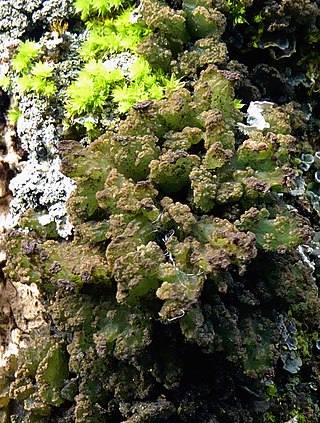
The Arctomiaceae are a family of lichenized fungi in the Ascomycota, class Baeomycetales. The family was named by Theodor Magnus Fries in 1861, with Arctomia as the type genus. Species in this family are found in arctic and subarctic habitats, usually associated with bryophytes.
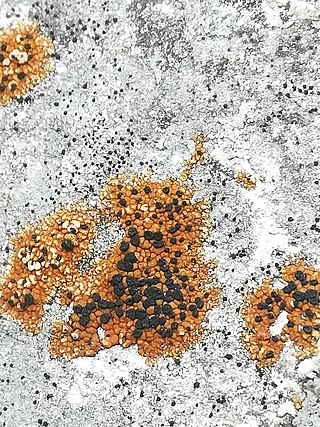
Phoebus is a fungal genus of previously uncertain familial placement in the order Arthoniales, now placed in the family Lecanographaceae thanks to molecular analyses. It contains only one species, Phoebus hydrophobius, found in the Ozarks of the central United States, and described as new to science in 2007.
Austropeltum is a genus of lichenized fungi in the family Sphaerophoraceae. The genus is monotypic, containing the single species Austropeltum glareosum, found in Australia and New Zealand.
Xyleborus is a genus of lichen-forming fungi in the family Stereocaulaceae. It has two species. The genus was circumscribed in 2009 by Richard C. Harris and Douglas Ladd with Xyleborus sporodochifer assigned as the type species. A second species, X. sporodochifer, was added to the genus in 2015.
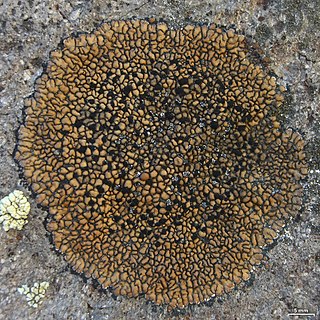
The Lecideales are an order of lichenized fungi in the class Lecanoromycetes. The order contains two families: the Lecideaceae, which contains 29 genera and about 260 species, and Lopadiaceae, which contains the single genus Lopadium of 10 species.
Endohyalina is a genus of 10 species of corticolous lichens in the family Caliciaceae. The genus was circumscribed by Bernhard Marbach in 2000, with Endohyalina rappii designated as the type species.
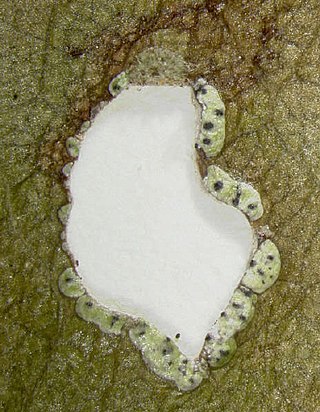
Strigulaceae is a family of lichen-forming fungi, one of two families in the order Strigulales. Recent (2020) molecular analysis of the type genus, Strigula, has led to a reallocation of the foliicolous species into six genera that correspond to well-delimited clades with diagnostic phenotype features.
Chrismofulvea is a genus of lichen-forming fungi in the family Caliciaceae. The genus was circumscribed by Austrian lichenologist Bernhard Marbach in 2000, with Chrismofulvea dialyta assigned as the type species. It was one of several segregate genera proposed by Marbach in his 2000 revision of American species of Buellia.
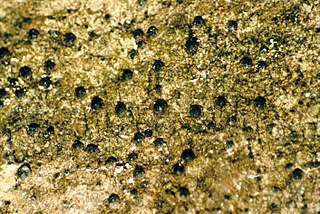
Scoliciosporum is a genus of lichens in the family Scoliciosporaceae.

Loxospora is a genus of lichen-forming fungi in the family Sarrameanaceae. It has 13 species. The genus was circumscribed by Italian lichenologist Abramo Bartolommeo Massalongo in 1852, with Loxospora elatina assigned as the type species. This crustose lichen was originally named Lecanora elatina by Erik Acharius in 1810.
Kalbographa is a genus of lichen-forming fungi in the family Graphidaceae. The genus was circumscribed in 2007 by lichenologist Robert Lücking with Kalbographa caracasana assigned as the type species. The genus name honours German lichenologist Klaus Kalb.













